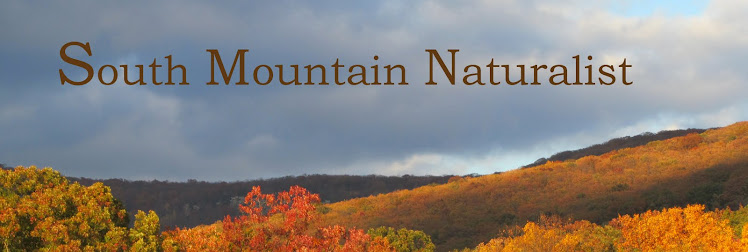Greenbrier is the name of a Maryland State Park in the Blue Ridge Mountains, on the westward slope of South Mountain.
The plant Greenbrier (Smilax rotundifolia) is a member of the Liliaceae family. It has heart-shaped leaves and tough, thorny stems that can form impenetrable thickets when many plants congregate together. Growing by itself, Greenbrier appears as a small shrub, but can use tendrils to climb trees or interweave with other shrubs. Greenbrier likes open woods, and is also commonly seen on the banks of streams, or where forests meet open areas. Trees typically sharing its habitat include Red and Silver Maples, White and Black Oaks, Eastern White Pine and Virginia Pine, American Beech, American Elm, Mockernut Hickory and Sweetgum. Also look for Sassafras, Wild Grape, Poison Ivy, Trumpet Creeper, Bracken Fern and Cinnamon Fern. Many of these plants are growing atGreenbrier State Park
Greenbrier plays an important role in the woodland habitat. White-tailed deer and rabbits feed on the leaves and stems. (The new growth at the tips of the vine are tender and sweet. They make a refreshing nibble for humans as well. ) Greenbrier provides protection from predators for small creatures. You will often find a Gray Catbird nest in a prickly clump of Greenbrier.
The plant Greenbrier (Smilax rotundifolia) is a member of the Liliaceae family. It has heart-shaped leaves and tough, thorny stems that can form impenetrable thickets when many plants congregate together. Growing by itself, Greenbrier appears as a small shrub, but can use tendrils to climb trees or interweave with other shrubs. Greenbrier likes open woods, and is also commonly seen on the banks of streams, or where forests meet open areas. Trees typically sharing its habitat include Red and Silver Maples, White and Black Oaks, Eastern White Pine and Virginia Pine, American Beech, American Elm, Mockernut Hickory and Sweetgum. Also look for Sassafras, Wild Grape, Poison Ivy, Trumpet Creeper, Bracken Fern and Cinnamon Fern. Many of these plants are growing at
Greenbrier plays an important role in the woodland habitat. White-tailed deer and rabbits feed on the leaves and stems. (The new growth at the tips of the vine are tender and sweet. They make a refreshing nibble for humans as well. ) Greenbrier provides protection from predators for small creatures. You will often find a Gray Catbird nest in a prickly clump of Greenbrier.
Like many plants, Greenbrier has co-evolved with insects. In early summer, small clusters of green flowers waft a sickly sweet odor that mimics a decomposing carcass. The scent lures Blue Bottle Flies who inadvertently assist the plant in pollination.
Later in the season, tiny blue berries provide food for Opossums, Raccoons, Wild Turkeys, Pileated Woodpeckers and many other types of birds.
Later in the season, tiny blue berries provide food for Opossums, Raccoons, Wild Turkeys, Pileated Woodpeckers and many other types of birds.

No comments:
Post a Comment